
Broadway Melody of 1936 is a musical film released by Metro-Goldwyn-Mayer in 1935. In New York, the film opened at the Capitol Theatre, the site of many prestigious MGM premieres. It was a follow-up of sorts to the successful The Broadway Melody, which had been released in 1929, although, there is no story connection with the earlier film beyond the title and some music.

Lew Brown was a lyricist for popular songs in the United States. During World War I and the Roaring Twenties, he wrote lyrics for several of the top Tin Pan Alley composers, especially Albert Von Tilzer. Brown was one third of a successful songwriting and music publishing team with Buddy DeSylva and Ray Henderson from 1925 until 1931. Brown also wrote or co-wrote many Broadway shows and Hollywood films. Among his most-popular songs are "Button Up Your Overcoat", "Don't Sit Under the Apple Tree", "Life Is Just a Bowl of Cherries", "That Old Feeling", and "The Birth of the Blues".
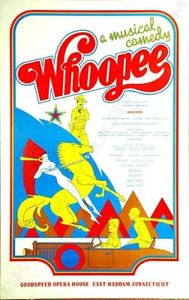
Whoopee! is a 1928 musical comedy play with a book based on Owen Davis's play, The Nervous Wreck. The musical libretto was written by William Anthony McGuire, with music by Walter Donaldson and lyrics by Gus Kahn. The musical premiered on Broadway in 1928, starring Eddie Cantor, and introduced the hit song "Love Me or Leave Me", sung by Ruth Etting.

Harold Arlen was an American composer of popular music, who composed over 500 songs, a number of which have become known worldwide. In addition to composing the songs for the 1939 film The Wizard of Oz, including "Over the Rainbow", Arlen is a highly regarded contributor to the Great American Songbook. "Over the Rainbow" was voted the 20th century's No. 1 song by the RIAA and the NEA.
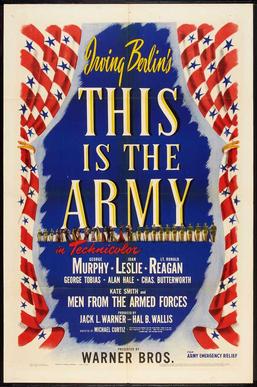
This Is the Army is a 1943 American wartime musical comedy film produced by Jack L. Warner and Hal B. Wallis and directed by Michael Curtiz, adapted from a wartime stage musical with the same name, designed to boost morale in the U.S. during World War II, directed by Ezra Stone. The screenplay by Casey Robinson and Claude Binyon was based on the 1942 Broadway musical written by James McColl and Irving Berlin, with music and lyrics by Berlin. Berlin composed the film's 19 songs, and sang one of them.
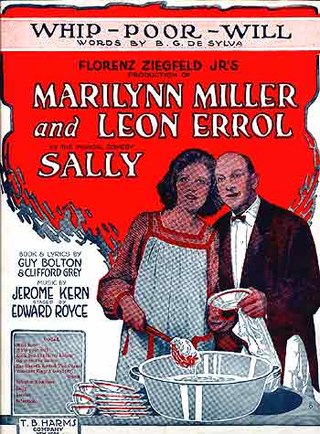
Sally is a musical comedy with music by Jerome Kern, lyrics by Clifford Grey and book by Guy Bolton, with additional lyrics by Buddy De Sylva, Anne Caldwell and P. G. Wodehouse. The plot hinges on a mistaken identity: Sally, a waif, is a dishwasher at the Alley Inn in New York City. She poses as a famous foreign ballerina and rises to fame through joining the Ziegfeld Follies. There is a rags to riches story, a ballet as a centrepiece, and a wedding as a finale. "Look for the Silver Lining" continues to be one of Kern's most familiar songs. The song is lampooned by another song, "Look for a Sky of Blue," in Rick Besoyan's satirical 1959 musical Little Mary Sunshine.
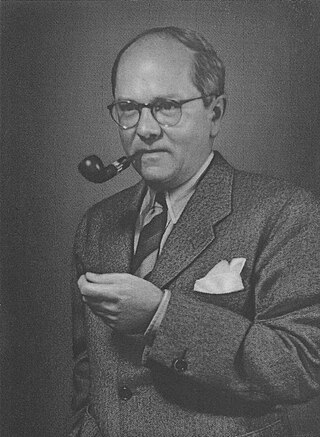
Richard Armstrong Whiting was an American composer of popular songs, including the standards "Hooray for Hollywood", "Ain't We Got Fun?" and "On the Good Ship Lollipop". He also wrote lyrics occasionally, and film scores most notably for the standard "She's Funny That Way".
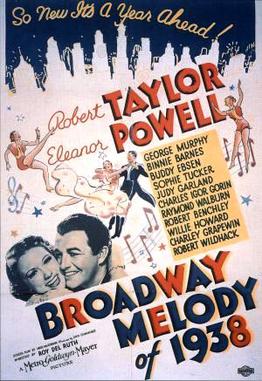
Broadway Melody of 1938 is a 1937 American musical film produced by Metro-Goldwyn-Mayer and directed by Roy Del Ruth. The film is essentially a backstage musical revue, featuring high-budget sets and cinematography in the MGM musical tradition. The film stars Eleanor Powell and Robert Taylor and features Buddy Ebsen, George Murphy, Judy Garland, Sophie Tucker, Raymond Walburn, Robert Benchley and Binnie Barnes.

John Frederick Coots was an American songwriter. He composed over 700 popular songs and over a dozen Broadway shows. In 1934, Coots wrote the melody with his then chief collaborator, lyricist Haven Gillespie, for the biggest hit of either man's career, "Santa Claus Is Comin' to Town." The song became one of the biggest sellers in American history.

Marilyn Miller was one of the most popular Broadway musical stars of the 1920s and early 1930s. She was an accomplished tap dancer, singer and actress, and the combination of these talents endeared her to audiences. On stage, she usually played rags-to-riches Cinderella characters who lived happily ever after. Her enormous popularity and famed image were in distinct contrast to her personal life, which was marred by disappointment, tragedy, frequent illness, and ultimately her sudden death due to complications of nasal surgery at age 37.
Harry Akst was an American songwriter, who started out his career as a pianist in vaudeville accompanying singers such as Nora Bayes, Frank Fay and Al Jolson.

Painting the Clouds with Sunshine is a 1951 Technicolor musical film directed by David Butler and starring Dennis Morgan and Virginia Mayo. The film is a musical adaptation of the 1919 play The Gold Diggers by Avery Hopwood, the fourth film adaptation of the play following The Gold Diggers (1923), Gold Diggers of Broadway (1929) and Gold Diggers of 1933 (1933). The film is a jukebox musical, featuring popular songs from the 1910s to 1930s, including two songs from Gold Diggers of Broadway and one song from Gold Diggers of 1933.
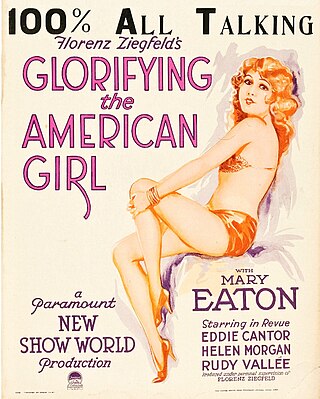
Glorifying the American Girl is a 1929 American pre-Code musical comedy film produced by Florenz Ziegfeld that highlights Ziegfeld Follies performers. The last third of the film, which was filmed in early Technicolor, is basically a Follies production, with appearances by Rudy Vallee, Helen Morgan, and Eddie Cantor.
"Let's Misbehave" is a song written by Cole Porter in 1927, originally intended for the female lead of his first major production, Paris. It was discarded before the Broadway opening in favor of "Let's Do It, Let's Fall in Love". However, the star of the Broadway production, Irene Bordoni, performed it for a phonograph recording which was labelled as being from the production of Paris.
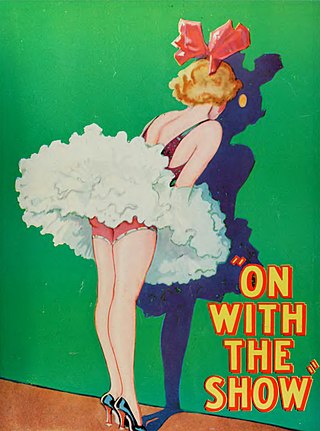
On with the Show! is a 1929 American pre-Code musical film produced by Warner Bros. Filmed in two-color Technicolor, the film is noted as the first all-talking, all-color feature length film, and the second color film released by Warner Bros.; the first was the partly color, black-and-white musical The Desert Song (1929).

The Show of Shows is a 1929 American pre-Code musical revue film directed by John G. Adolfi and distributed by Warner Bros. The all-talking Vitaphone production cost almost $800,000 and was shot almost entirely in Technicolor.

On the Avenue is a 1937 American musical film directed by Roy Del Ruth and starring Dick Powell, Madeleine Carroll, Alice Faye, George Barbier, and The Ritz Brothers. Many of the songs were composed by Irving Berlin. Many of the plot details were used in Let's Make Love. Initially, the movie was called Out Front.

Lord Byron of Broadway (1930), also known as What Price Melody?, is an American Pre-Code musical drama film, directed by Harry Beaumont and William Nigh. It was based on a best selling book by Nell Martin, which "was widely praised by critics as an extremely true and amusing romance of stage life." It was filmed in black and white with two-color Technicolor sequences.

The Hard Way is a 1943 Warner Bros. musical drama film directed by Vincent Sherman and starring Ida Lupino. The film was based on a story by Irwin Shaw which was reportedly based on Ginger Rogers' relationship with her first husband, Jack Pepper and her own mother, Lela.

Memory Lane is a 1929 black and white American musical film. It is an adaption to the play The Understander, written by Jo Swerling.



















